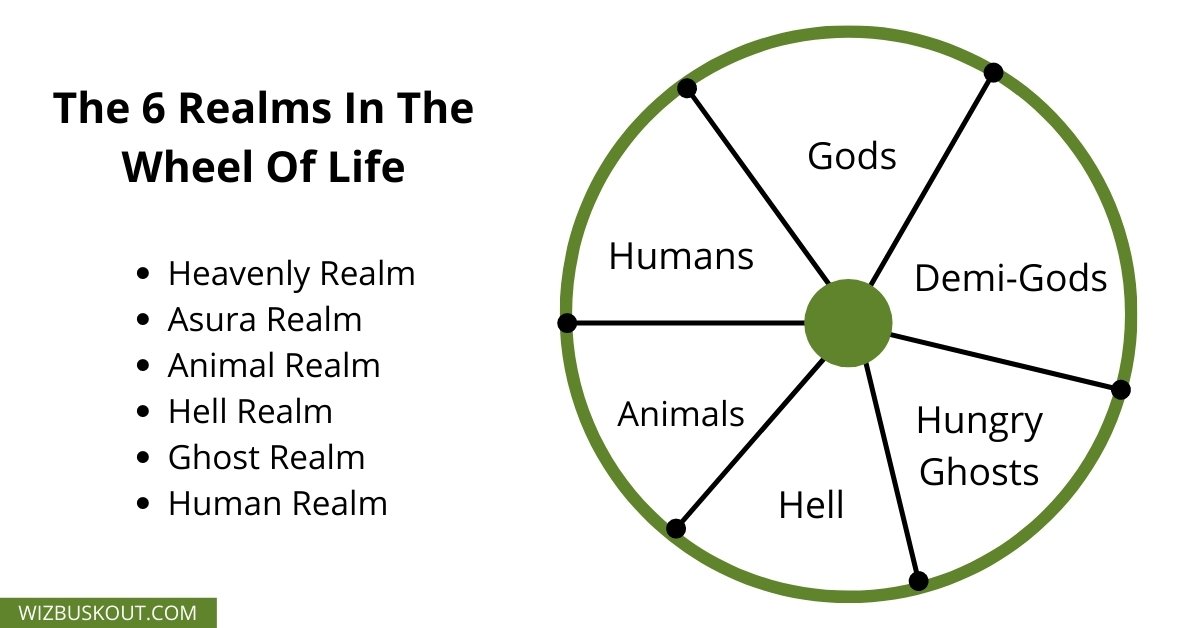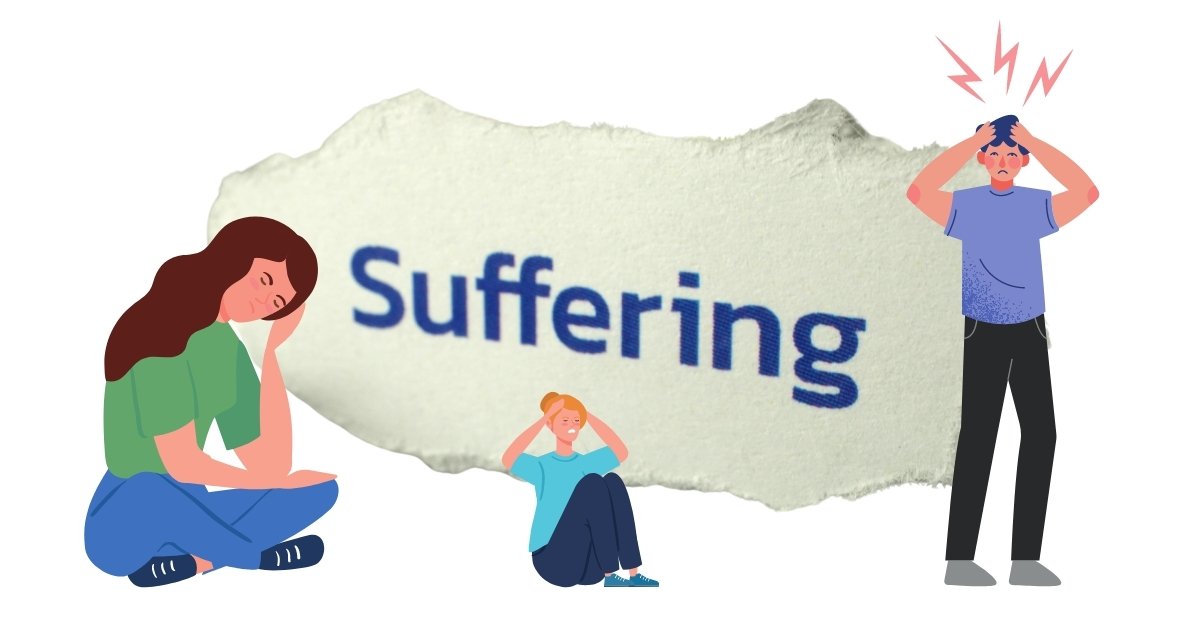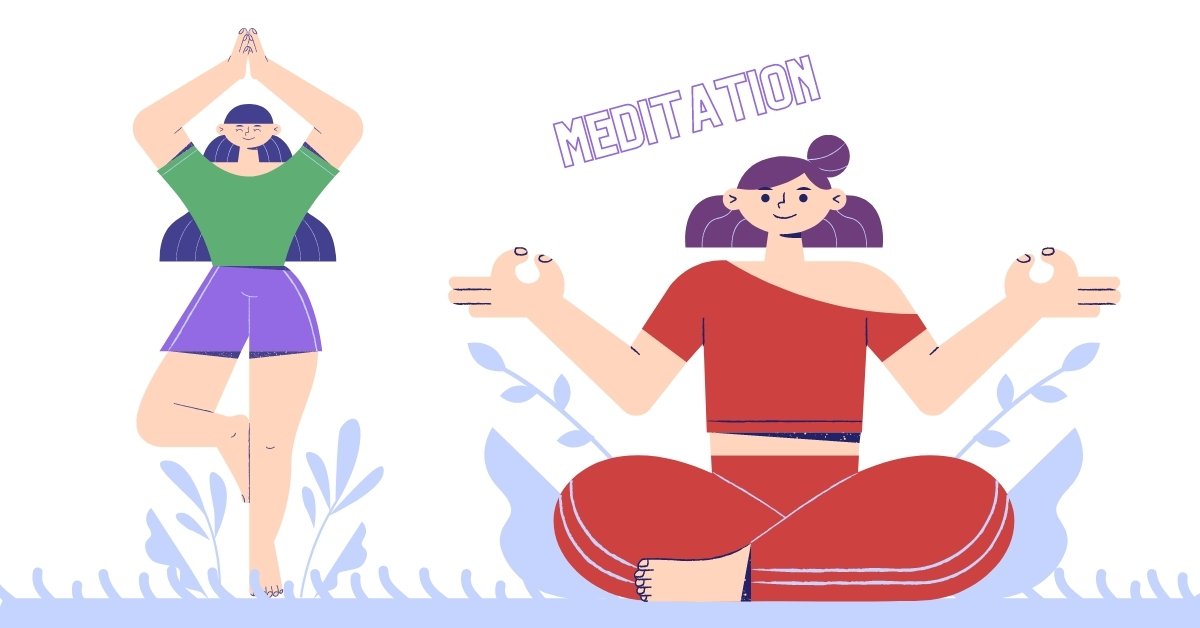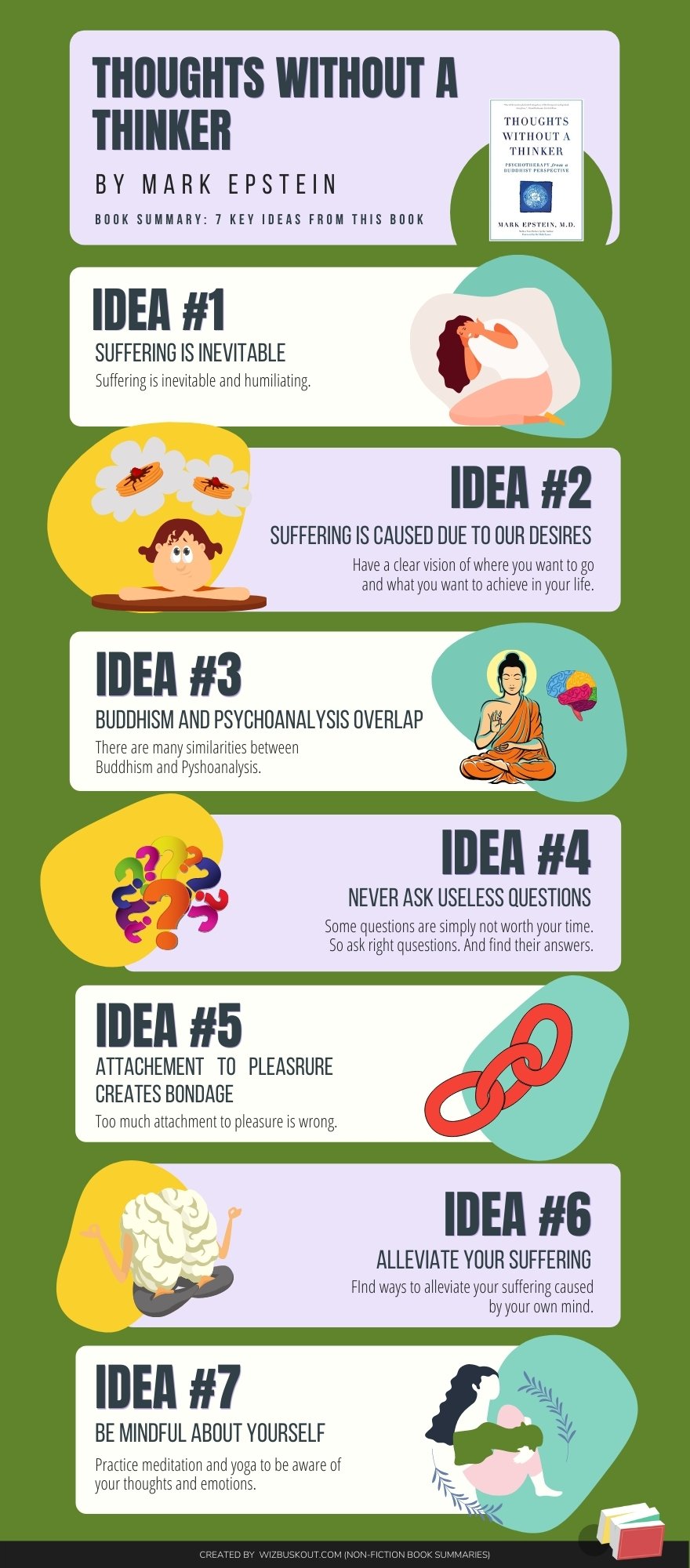Quick Summary: Thoughts Without A Thinker by Mark Epstein discusses the similarities and differences between the teachings of Buddha and psychoanalysis. Ultimately, this book helps you realize that suffering is inevitable and how you can alleviate your suffering, thus live a happy and peaceful life.
[amazon box=”0465050948″ template=”horizontal”]
Thoughts Without A Thinker Summary (PDF)
Ever thought about why we all feel incomplete?
Do you want to learn how to be peaceful?
Have you ever had annoying psychological issues?
Are you interested in reading about the teachings of the founder of Buddhism, Buddha?
If you said yes to any of the above questions, then this book summary is worth your time.
Alright, so without further ado, let’s dive right in!
1. The Buddhists’ wheel of life represents our mental states during our lifetime

Don’t worry if you don’t know about “The wheel of life.”
The circle is also known as “Bhavchakara” in Sanskrit.
So what it is? And why should you care about it?
The Wheel Of Life represents the states of our mind or consciousness.
For example:
We all have qualities of animals, humans, and the divine.
Just like animals, we also need food, water, and safety to survive.
But animals don’t need a higher purpose.
They are okay with wasting their time. They don’t feel bad when they procrastinate. They don’t need to impress their peers, or do they?
Animals are purely driven by their impulses and instincts.
So if a person doesn’t have a higher purpose or is living according to his conditioning, he is living with the consciousness of animals.
When you have a purpose, you have a human quality.
Human qualities are represented by creativity, movement, life, purpose, etc.
Most of us have such qualities, which makes us human.
But our problems still exist. (They must be fixed)
The third quality is of the divine: which is beyond the boundaries of ego, attachment, lust, hatred, and ignorance.
So during our lifetime, we move from one state to another.
When we are full of hatred and violence, we act like animals.
When we are full of creativity and passion, we behave like humans.
And finally, when we are working towards a higher purpose or something beyond our selfish ego, we represent divine nature.
The author takes reference from Buddha’s teachings and talks about the 6 different realms in The Wheel Of Life.
Let’s take a quick overview so that you get a brief understanding of each of them.
These are the 6 realms in the Bhavchakra (The Wheel Of Life according to Buddhism):
- Realm #1: The Hellish Realm (represents tortured mind)
- Realm #2: The God Realm (represents peaceful mind)
- Realm #3: The Human Realm (represents confused and incomplete mind)
- Realm #4: The Demi-God Realm (represents mind filled with jealousy)
- Realm #5: The Animal Realm (represents selfish or impulsive mind)
- Realm #6: The Hungry Ghost Realm (represents helpless mind with dissatisfaction)
The truth is:
In every realm, there is suffering.
Yes, even in the Heaven realm.
Every realm has a Buddha element (Bodhisattva), which reminds us of Buddhahood.
Buddhahood, according to Wikipedia, represents a person who has resolved to become a Buddha or become enlightened ( has attained self-realization).
Or in simple words: It represents a possibility where there is no suffering or something better than our current state of life.
The goal of life according to Buddhism is to go beyond this cycle of states: To be free from all the suffering.
No matter what we do, we can’t avoid suffering in our lives.
You might say, “I’m fine. I never suffer.”
But that’s not true.
Let’s discuss how everyone suffers in his life from a Buddhist perspective.
2. Suffering is inevitable and humiliating

It may sound pessimistic, but suffering is unavoidable.
That’s the reality.
The Buddha says that suffering is inevitable.
How?
Just think about it.
We all suffer physically, psychologically, and spiritually.
Our bodies get diseases and decay with time. Our bodies become weak over time. And we all die after living a few 80-100 years. That’s physical suffering.
Psychologically, we all get confused and feel a sense of incompleteness. And therefore, we chase after sensory pleasures, which again, never quench our thirsts. That’s psychological suffering.
Spiritually, we never realize our true identity and keep asking questions like:
“Who am I?”
“Why do we even exist?”
Such questions have no proper answers.
Some ancient scriptures talk about it. But still, there is no scientific evidence.
And most of what we hear from people is, most of the time, false and purely imaginative.
The problem is:
Most people never realize that there is suffering. They remain confused about themselves — about their self-image.
The Buddha believed that suffering is humiliating in itself.
“That’s why everyone must learn how to think clearly.”
The Buddha believed that most of our suffering is the product of our minds and self-created.
So if we understand our minds, maybe we will be able to end our suffering, or at least minimize it.
Won’t that be good?
It’d be amazing, right?
Who wants to suffer anyway?
The Wheel Of Life that we discussed above represents our mental states.
It will help you become mindful or raise your self-awareness and thus tap into your divine nature.
Recommended: Freedom From The Known Summary
3. The cause of our suffering is our thirst to fill our incompleteness
According to Buddha, suffering is caused by our unfulfilled desires.
We all feel incomplete within us.
So we get an idea that we get all the pleasures in the world, maybe then we will become complete.
But does it ever happen that after indulging in any sensual gratification activity you get permanent satisfaction?
It doesn’t, right?
No matter what luxury you enjoy, the sense of completeness fades after some time. Then you try to find something else to fulfill your desires.
Can you see the pattern?
The more desires we have, the more we run after objects of this world to satisfy us — only to realize that we will never be complete.
This is psychological suffering as nothing fully satisfies our minds.
But on the flip side, if there are no desires, there is no disturbance in the mind.
Then whatever we do, it comes from a point of peacefulness.
If you are already complete, then there is no need to find something to fill your void.
This is self-realization in some way.
Once you realize that you don’t need to attain anything, once you realize what your true nature is, you become capable to end your psychological suffering.
We can’t do much when it comes to physical suffering, but psychological suffering can be minimized if one studies the nature of his mind.
Maybe then there will be a possibility of liberation.
Liberation from what?
The liberation from suffering. (What could be more important than that, right?)
Those who make this their goal, go on the path of spirituality.
Once you understand that all life is filled with suffering, you must find ways to minimize it.
Also read: Be your own sunshine summary
4. Our inflated or deflated sense of self causes psychological problems
The author has discussed how Buddhism and psychoanalysis consider our inflated or deflated self-image as the cause of many psychological issues.
Most people who have an inflated self-image believe that there is some Supreme Power that they can attain or surrender to.
They believe in the existence of a super-self.
While people who have a deflated self-image believe that there is no self and there is no meaning to anything.
They tend to go into depression.
These are the two extreme cases, though.
The truth is:
Nobody knows whether there is a true self or not.
Even Buddha remained silent on such questions and believed that they were false questions that didn’t have an answer.
And therefore he remained silent whenever his followers asked such false questions, the author says.
So does the true self exist?
If YES, then how do we realize it?
If NOT, then who is the real thinker behind our thoughts?
Or is there anything else that we don’t know about?
You see, there are so many questions that need to be answered.
Sadly, most of them can’t be answered by pure logic or science.
If you go by the Buddha philosophy, it’s better to focus on our suffering rather than asking such fantasy questions about the existence of other worlds.
Isn’t it?
If we think logically, we can never know the answers to such questions.
So why waste our time thinking about them.
Shouldn’t we invest our time in destroying our delusions and biases? Of course, we should.
It’s better to make our minds clear about such notions and try to live a quality life.
The caveat is:
If you have an inflated self-image, you are more prone to become an egoist.
And if you have a deflated self-image, your life will lose its colors.
I think balancing our self-image and understanding our minds is the best way to approach such psychological problems.
That’s the reason, the author has drawn parallels between Psychoanalysis and Buddhism. They both relate to each other in many ways.
The best part is:
Buddhism’s philosophy is highly pragmatic. (Based on this book and my research so far)
Let’s talk about it in the next lesson.
Recommended: Rewire your anxious brain summary
5. Suffering may only end by destroying greed, hatred, and ignorance within us
At the center of the Bhavchakra (The Wheel Of Life), there are 3 animals: cock, pig, and snake.
They represent:
Greed, hatred, and ignorance.
And according to Buddhist philosophy, one can never attain freedom from suffering as long as he has these 3 characteristics.
Let’s talk about how each of these characteristics affects our minds, and thus our lives.
- The first characteristic is GREED.
A greedy person is always dissatisfied with his life.
For instance, if a person is greedy for money. He will never have enough money.
Even if he becomes a millionaire, he will keep looking for more.
So his entire life will be spent earning money and he will not be able to fulfill spiritual goals. Those thoughts about self-realization won’t occur in his mind.
He will thus always live in bondage as long as he remains attached to money.
Even today, most of the problems in the world are due to human greed.
The problem is:
A greedy mind not only destroys his happiness but also makes other people’s lives worse.
So you can imagine how dangerous it is for our minds.
Greed and lust are similar in nature.
The only difference is greed is never fulfilled while lust can for a temporary time.
But none of them ever give everlasting joy.
- The second characteristic is HATRED.
Hatred is the exact opposite of love.
Please note there that love is not the same as attachment.
J Krishnamurthi says that the moment you start thinking about it — it is not love.
Love is without any selfishness.
But hatred is full of selfish behavior.
When you are having hatred inside you, you only care about revenge.
So it again creates bondage for you.
Because you feel that without revenge, you will be incomplete and unhappy.
Which is not true at all.
No matter what the situation is, hatred can never bring you peace. And if it does, it’s surely temporary. Hatred only brings guilt in the end.
In short: Hatred is also a root cause of psychological suffering.
Where there is hatred, there is violence.
And where there is violence and agitation, there is no peace and harmony.
- The third characteristic is IGNORANCE.
What is ignorance?
Ignorance is when you don’t know who you are, but you think that you know everything.
A wise person is full of wisdom.
On the flip side, a fool is full of ignorance.
A wise person never thinks that he knows everything. But a fool, since he doesn’t know ‘how much he doesn’t know,’ keeps believing that he knows it all.
Sure it sounds funny. But you can see it everywhere these days.
So an ignorant mind never understands his mind.
And thus keeps suffering throughout his life.
Long story short:
If you want to live happily, you must destroy greed, hatred, and ignorance within your mind.
And if you observe your mind closely, you’ll realize that greed and hatred are connected with ignorance.
Only an ignorant mind gets attached to greed and hatred.
Have you ever seen a wise person worrying about why there is an unequal distribution of wealth in this world?
Sure, he knows about it. But he never goes into depression by just thinking about the problems.
Recommended: Ego Is The Enemy Summary
6. The best way to dispel our ignorance is to become mindful

Ignorance doesn’t exist in itself.
Ignorance is like darkness.
Darkness doesn’t exist on its own.
When there is no light, there is darkness.
In the same fashion, when there is no knowledge or understanding of the mind, there is ignorance.
According to Buddhist philosophy, mindfulness is the key to destroying ignorance.
What is mindfulness?
Mindfulness is simply being in the present moment and be aware of the tendencies of your mind like greed, hatred, anger, ignorance.
What’s the difference between an average person and a mindful person?
An average person possesses all those tendencies which are at the center of the Bhavchakra.
But a mindful person is fully aware of what’s going on in his mind.
For instance, when you are angry, can you observe how thoughts are rapidly increasing in their intensity and numbing your cognition?
If you can, you are mindful.
And if you can’t, then you should practice meditation, and grow your awareness about your mind.
Most people try to run away from their emotions.
But Buddhism asks us to address our suffering and realize that we can’t escape our emotions.
The best way is:
To address our thoughts and emotions as they are and grow our understanding. And realize that our emotions are just thoughts, and thoughts are just words.
Escaping from our problems can never be the permanent solution.
Of course, you can run away for some time, but ultimately, you’ll get tired.
Have you ever thought about why we are so afraid of our emotions?
The answer is:
We never bother to pay attention to our minds. But when the intensity of thoughts increases, emotions build up, they go out of control.
That’s what scares us.
We become uncertain about our self-image.
So stay mindful.
Pay attention to your thoughts and emotions.
Observe how you feel when a certain emotion builds up inside your mind.
Do you know who gives power to our emotions?
It’s us. Since we don’t understand our minds, emotions influence our behaviors.
Are emotions bad? No emotions are just emotions.
It depends on your ability to handle them.
The more you understand your mind, the less you suffer.
Recommended: Think Like A Monk Summary
7. Some questions are fundamentally flawed and have no answers
Budhha used to avoid useless questions.
But do you know why?
Well, our minds crave certainty.
There are things that we don’t know yet like if there is a God or not.
Science is still looking for answers to such questions.
But as expected, Buddha was a wise man.
When we think that our Self is something grandiose, we inflate our ego.
And when we think that there is only a void and everything is meaningless, we are filled with depressing thoughts.
Both the states are harmful.
Another reason why such questions should be avoided is:
They don’t help in reducing our suffering. And if they do, it’s probably for a moment or on a superficial level.
Let’s assume that our Self is grandiose and limitless.
Now it might give a boost of motivation.
But as I always say motivation is temporary. And anything temporary can’t fulfill your thirsts, which are permanent.
You can’t become certain with something uncertain.
Now let’s consider the other case that our Self is void.
When we believe that everything looks meaningless.
One may think “why not simply give up on life?”
As you can see, the suffering is only going to increase in either case.
What was the goal of Buddha who was enlightened?
It’s was to end the suffering that we get during our lifetime.
The moment we take birth, the cycle of suffering starts.
But we are more concerned talking about psychological suffering here as there is no way we can avoid birth, death, and decay.
Or can we?
We might develop tools to slow down the aging process.
But still, one can’t avoid death. It’s inevitable — no matter how pessimistic it may sound to you right now.
So according to Buddha, we must focus on solving the problems that give us suffering.
And stop asking pointless questions that either inflate or deflate our ego.
It’d be better if we could destroy the ego itself instead of finding answers to the questions that don’t help in alleviating our psychological suffering.
8. Buddhism doesn’t reject pleasure — it rejects the attachment to pleasure.
The author makes it clear that Buddhism doesn’t tell you to reject pleasure and always live in suffering.
The problem is:
We build a wrong belief that the sources of our pleasure will fill the emptiness inside our hearts.
But the reality is, they can’t.
Attachment to such sources of pleasure deludes us.
Is pleasure bad? No.
But the attachment to pleasure is bad.
Make sense? Okay.
The core teachings of Buddha ask us to dispel our ignorance and see that the things that give us sensory pleasure are mere delusions.
But as long as one remains ignorant, he keeps believing that somehow those objects that provide his sensory pleasure would fulfill his deepest desires.
As you already know, desires are the biggest cause of our suffering.
Why do you think we all feel incomplete?
You guessed it right, we all have desires.
Our desires always make us feel that something is missing.
It feels like a puzzle with a missing piece.
So we go out in the world and try our best to find that missing piece.
We all want to solve that big puzzle inside our minds.
Why? Because it makes us feel restless all the time.
But unfortunately, we all fail to find that missing piece.
Sometimes, we get deluded and think that objects of pleasure are the missing piece. But later, we find out that the piece was fake.
Then we go again…
We don’t know what is missing.
We don’t know what the missing piece looks like.
Or do we?
That’s our suffering!
And nobody knows how to fix this.
Now there are two approaches here:
Either you hunt for that missing piece. Or you avoid what’s stopping you from finding it.
Since we don’t know anything about the missing piece, it’s better to learn more about the minds and try to understand the puzzle.
Maybe then we will be able to figure something out.
Most people fall into the trap, and imagine things in their mind.
They don’t have any data about the missing piece that we are talking about over and over again.
So what do they do? They imagine.
Again, imagination is a delusion.
How? Because imagination has nothing to do with reality.
What Buddha wanted was to alleviate the suffering here and now — in our real life.
When we read that avoid sensory pleasure, we misinterpret it and think that we should reject all the pleasure in the world.
But that is wrong:
Buddhism doesn’t ask you to live in suffering.
The Buddhism philosophy is to avoid extremes and find a middle path.
So don’t indulge in experiencing all the pleasures of the world. And at the same time, don’t starve yourself of pleasure.
Experience pleasures in moderations.
Keep in mind that all sensory pleasures are momentary.
Avoid extreme attachment to anything as it causes agitation in our minds.
Recommended: The Happiness Trap Summary
My personal thoughts on Buddhist philosophy
I tried my best to give you an unbiased summary of this book.
The author has discussed how there are many familiarities between Psychoanalysis and Buddhism.
But here, in this book summary, I have focused more on Buddhism.
Why? Because I don’t know much about psychoanalysis.
And since both of them are related, you have learned the basics.
Personally, I like Buddhism as they focus on practical techniques.
The most important thing in life is to end our sufferings, isn’t it?
And that’s what Buddha tried to do.
Kudos to Buddha here!
We all tend to fantasize about such philosophical concepts.
But Buddhism tries its best to stick to what we know. At the same time, it doesn’t stop us from doubting what we know.
It allows us to explore and question our already-known concepts.
Isn’t it great?
Anyway, you can always go on your own spiritual journey and reach a different conclusion than mine.
Or who knows, maybe you realize something else entirely.
Our minds are powerful. It all depends on how you use it.
You can let things go as they are in your mind. Or you can understand your mind for good and use it to alleviate your mental issues.
You know, in some way, we all suffer psychologically.
Thoughts Without A Thinker Quotes
Here are some of the notable quotes from this book by Mark Epstein:
To study Buddhism is to study the self. To study the self is to forget the self. To forget the self is to be one with others. ~Zen Master Dogen
Happiness is the real possibility, taught the Buddha, if we can but penetrate our own narcissism. ~Mark Epstein (based on Buddha’s teachings)
All worry about the self is vain; the ego is like a mirage, and all the tribulations that touch it will pass away. ~Buddha
Instead of letting our misconceptions about our feelings influence our understanding, we must let our understanding change the way we experience our emotions. ~Mark Epstein (based on Buddha’s teaching)
The Key Takeaways from “Thoughts Without A Thinker Summary”
Let’s recap the key ideas from this book summary:
- Although different, psychoanalysis overlaps with Buddhism in many areas.
- According to Buddha, suffering is inevitable.
- According to Buddhists, suffering is caused due to our desires.
- Suffering can end, provided that a person learns about himself and dispels his ignorance.
- Mindfulness is the key to eliminate ignorance from our lives.
- Pleasure is not the problem — attachment to pleasure is the problem.
- Our inflated or deflated sense of self is the cause behind many psychological issues.
- Buddhism is highly pragmatic as it focuses on seeing reality as it is and alleviating the suffering of mankind.
- A person’s focus must be on finding ways to alleviating his suffering by looking at his current reality and stop fantasizing about the existence of a grandiose self.

Thoughts Without A Thinker Review
[amazon box=”0465050948″ template=”horizontal”]
This book was okay, I’d say.
The first 2-3 chapters were great.
But I didn’t enjoy reading the second half of this book.
This book is complex to understand.
The author just dives into discussing Buddhism and psychoanalysis.
So a person who doesn’t know anything about any of them would find it hard to complete.
That’s why I don’t recommend this book to beginners.
Also, most of the chapters were directly discussing the teachings of Buddha.
Only read this book once you are aware of Buddhism and its teaching.
Even I had to do extra research to finish this book summary.
The later chapters don’t give much context.
Also, I didn’t like the areas where the author just started throwing Freudian discoveries about psychoanalysis.
You might find this book interesting if you are a geek like I am.
But surely, an average person who doesn’t know much about Buddha or Buddhism would get bored in the first few chapters.
The best part of this book was where the author discussed The Four Noble Truths by Buddha.
I also enjoyed reading about The Wheel Of Life (Bhavchakra).
After reading about it, I realized that most teachings in the religion are symbolic.
That means the mythical stories we hear in the ancients scriptures are there to teach us something more than the story itself.
For instance, in this book, The Wheel Of Life tells us about our mental states. But when you look at its picture, you’ll see that there are ghosts, gods, demons, demi-gods, animals, etc.
But they all represent a human quality. They are not there for mere entertainment.
They teach us about our human tendencies — about our minds.
Book Rating: 6/10
Now It’s Your Turn
That’s it for now.
I hope you learned a lot of lessons about Buddhism philosophy and will be able to take 2-3 golden nuggets of wisdom from this to apply in your daily life.
What do you think about Buddhism’s philosophy?
Do you believe in the grandiose self or do you believe that our Self is nothing but a void?
In case you know more about it, feel free to write in the comments below.
Share this book summary with your friends and family member and alleviate their psychological suffering so that they also live a happy and peaceful life.
